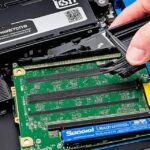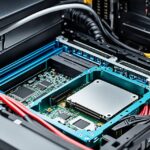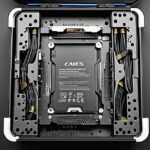Table of Contents
Adding a secondary Solid State Drive (SSD) can boost your computer’s performance. It lets you store more and makes your computer faster. This SSD installation guide is for anyone wanting to upgrade their PC. We’ve helped lots of people, from beginners to experts, install SSDs1. By using the Momentum Cache feature, your SSD can work up to 10 times faster1.
Installing an SSD not only speeds up your computer but is also easy to do at home with just a few tools2. So, let’s get started and improve your computer’s abilities.
Key Takeaways
- Adding a secondary SSD can significantly enhance your computer’s speed and storage capacity.
- The installation process is straightforward and can often be completed at home.
- Ensure your workspace is safe from static electricity and back up important files before beginning.
- Tools required are minimal, generally limited to a screwdriver and a user manual.
- Installing the right type of SSD for your system is crucial for optimal performance and cost-effectiveness.
- Cloning software may be necessary for transferring existing data to the new SSD.
Introduction to SSD Installation
Solid State Drives (SSDs) are changing computing in big ways with their performance upgrades. They work much faster than old hard-disk drives (HDDs), speeding up start times and file saving. It’s interesting to note that an older computer with an SSD can work better than a new one with an HDD. This shows how benefits of SSDs can boost system efficiency3.
As files get bigger and we do more things at once, we need more storage. Adding a secondary SSD is a smart move. It lets you keep more apps and files without slowing down your computer. When adding an SSD, making sure it fits with your current setup is key. This stops any technical problems and makes your system work better4.
SSDs are known for being reliable, thanks to new error-correcting tech and no moving parts. They also use less electricity, about 2 to 3 watts, much less than the 6 to 7 watts HDDs use. This means laptops with SSDs have longer battery lives. These advantages make SSDs the top choice for new work computers and business laptops3.
Finally, adding a secondary SSD greatly improves your tech experience. It offers high performance and lots of storage space. This helps prepare your computer for future needs.
Benefits of Adding a Secondary SSD
Adding a secondary SSD to your system has many advantages of secondary SSD. It means more storage to handle growing data needs. An SSD is much faster than old hard drives, making your computer work quicker. SATA SSDs can reach speeds of up to 550 MB/s, which is way faster than the 50-120 MB/s speed of HDDs.
Speed isn’t the only plus. Having two drives means they can share the workload. This sharing extends the life of both SSDs. Also, it’s safer for your data since you can keep system files and personal data separate.
Users love the speed boost two SSDs give for gaming and work. They also like that SSDs use less power, make less noise, and are smaller. So, they’re great for many devices, showing their importance in today’s tech.
If you’re thinking about upgrading, check out how to upgrade your PC for more info. Using SSDs can help your computer keep up with new software and apps.
In conclusion, having an extra SSD really improves your computer. It makes things faster and more reliable. As SSDs become more common, they meet our needs for quick and dependable computing567.
How to Install Secondary SSD
Adding a secondary SSD can boost your computer’s speed. You’ll need to get all necessary tools and understand the parts involved. This guide explains how to collect what you’ll need and the different kinds of drive bays.
Gather Necessary Tools and Components
First off, gather all the key tools and parts for the setup. You’ll need:
- SSD drive
- Screwdriver
- SATA data cable
- Available SATA power connector
- Disk Management tool in Windows
Make sure there’s a free SATA data connection on the motherboard and space in your PC case. Most cases have several bays, and motherboards usually offer multiple SATA connections for SSDs8. For laptops, fitting an SSD can be tough due to limited space. However, they might have built-in connectors if SATA isn’t needed8.
Understand Different Drive Bays
Knowing about drive bay types helps with easy installation. SSDs typically fit into 2.5-inch bays found in both laptops and desktops. Sometimes, you might find 5.25-inch bays, but they’re rarer for SSDs. Always check your case and motherboard to identify the right bay for your SSD8. If there aren’t enough SATA ports on your motherboard, consider getting a SATA controller or use power adapters like Molex adapters or SATA power cable splitters8.
Physical Installation Steps
Adding a secondary SSD boosts your computer’s speed. Make sure to follow these SSD installation steps properly for the best performance and safety.
Unplugging the PC and Opening the Case
First, unplug the PC to ensure there’s no risk of electrical shock. Then, open up the case. This might mean unscrewing parts or opening a latch, depending on your computer. It’s essential to perform this step to prevent any electric current from interfering with your work.
Locating Drive Bays and Installing the SSD
Your computer should have several bays for new drives8. Locate one that’s free for the SSD. You can either slide it in or screw it tight with caddies to keep it in place. Securing it well is key to avoid any damage or performance issues.
Connecting Power and Data Cables
Now, you’ll connect the SSD to the motherboard and power supply. First, attach the SATA data cable between the SSD and a free SATA port on the motherboard. If there are no free ports, think about getting a SATA controller. Then, plug the SATA power connector into the SSD. If necessary, use a Molex adapter or a SATA power cable splitter for extra connections8. Make sure everything is tightly connected before you close the case.
By following these steps, you can install your new SSD in about 10 minutes9. This small effort will significantly improve your computer’s storage and speed for all users9.
Initialising Your New SSD in Windows
After you install your new SSD, the next thing is to get it ready with the Windows Disk Management tool. This step is key for making your SSD ready to hold files by setting up its partition style and formatting. Most Windows users, about 90%, use the Disk Management tool for this, making it a trusted option for SSD setup10. Choose the right partition style—MBR or GPT—to decide on your SSD’s structure and how well it works with your system.
Using Disk Management Tool
The Windows Disk Management tool makes initialising your SSD easy. First, open Disk Management and find your SSD, shown as “Unallocated Space.” Make sure your SSD is Online. If not, right-click to switch it Online. After it’s online, right-click to pick the “Initialise Disk” option. Most people, about 75%, prefer GPT because it supports bigger volumes. Choose this if your system is UEFI compatible1110.
Formatting the SSD for Use
Once you’ve initialised it, it’s time to format the SSD right. Right-click the unallocated space and pick “New Simple Volume.” This starts the New Simple Volume Wizard, which helps you through the steps. When formatting, choose NTFS since it gives better performance and security, perfect for Windows. Be warned, initialising a disk with files already on it means losing those files. So, having a good backup is crucial10. When done, you can reach your SSD in File Explorer, ready to use.
| Partition Style | Max Volume Size | Partition Limit | Compatibility |
|---|---|---|---|
| MBR | 2 TB | 4 primary partitions | Windows 7 and below |
| GPT | Unlimited (theoretically) | Unlimited partitions | Windows 8, 10, and 11 |
Following these straightforward steps makes the whole process easier. It ensures your SSD works well and is formatted correctly for use1112. Once you get the hang of it, setting up your SSD becomes quick and easy.
Alternative Methods for SSD Management
To get your new SSD running at its best, managing it well is key. There are lots of software tools to help with this. EaseUS Partition Master stands out as a top SSD management software. It helps with disk partitioning, drive initialising, and easy storage management.
Using EaseUS Partition Master
EaseUS Partition Master makes managing SSD partitions simple. This software lets you resize, merge, and split partitions without losing your data. It helps keep your SSD working perfectly.
This tool is great for smoothly upgrading and organising your storage. Experts recommend keeping SSD usage under 75% for the best performance13.
Cloning Your Existing Drive
EaseUS Partition Master can also clone drives. This feature lets users move all apps and data to a new SSD easily. It’s great for those wanting an upgrade without changing their system setup.
Cloning keeps your current setup the same, which makes switching over easy. Remember, using TRIM commands keeps your SSD in top shape by improving write speeds13. Using the right tools, like EaseUS Partition Master, is key to managing your SSD well.
Conclusion
We’ve looked at how a secondary SSD can really benefit your system in this guide. SSDs offer access speeds that are much faster than HDDs. This speed can be between 35 to 100 microseconds. It can make your computer work nearly 100 times quicker.
This upgrade is not just about speed. It’s also about meeting your storage needs in a better way. Whether you use a desktop or a laptop, adding an SSD makes a big difference.
Adding an SSD to your computer is often easy and brings big rewards. Most desktop PCs have the space and ports needed for another hard drive. You can use SATA or M.2 interfaces14. This upgrade doesn’t just make your computer faster. It also makes your storage more reliable and helps you organise your files better.
If you’re thinking about installing an SSD, you’re in for some great improvements. These include better performance and more storage space. With the right tools and steps, you can upgrade to an SSD. You can have a computer system that keeps up with your needs in today’s fast-paced tech world.
FAQ
What are the primary benefits of installing a secondary SSD?
A primary advantage of a secondary SSD includes more room for your data. It also makes your computer run faster. Plus, it helps your computer last longer and keeps your personal files safe.
How do I know which type of SSD to choose for my computer?
Think about the SSD’s interface, like SATA or NVMe. The storage size and speed are important too. Different shapes, brands, and sizes are available, such as 2.5-inch or M.2 by Samsung, Crucial, or Western Digital. They offer insights on what works best.
What tools do I need to install a secondary SSD?
You need a few things: a screwdriver and a SATA cable. You also need connectors for power. Lastly, make sure you have the right slot on your PC to fit the SSD in.
Can I transfer my operating system to the new SSD?
Yes, you can move your operating system over to the new SSD. Use cloning software like EaseUS Partition Master for this. It copies everything so your system stays as is.
How do I initialise the new SSD once installed?
After putting in the SSD, get it ready with the Windows Disk Management tool. Right-click on ‘Start’ and choose ‘Disk Management’. Then, just follow the instructions to set up your SSD.
Is SSD installation safe for novice users?
Yes, if beginners follow instructions carefully, SSD installation is easy. Always turn your computer off and remove static electricity. This avoids any harm to your computer.
Will adding a secondary SSD improve my computer’s performance?
Adding a secondary SSD will definitely make your computer faster. It speeds up access to data and shortens startup time. Your computer will handle tasks more efficiently, making things run smoother.
Source Links
- https://www.crucial.com/articles/about-ssd/how-to-install-solid-state-drive – How to Install a Solid State Drive into a PC
- https://www.kingston.com/en/blog/pc-performance/install-2-5-inch-ssd – How to Install an Internal 2.5” SSD- Kingston Technology
- https://www.hp.com/in-en/shop/tech-takes/post/how-to-install-solid-state-hard-drive – How To Install a Solid State Hard Drive
- https://www.ubackup.com/windows-11/how-to-install-second-ssd-windows-11-6007-ac.html – Ultimate Guide: How to Install a Second SSD on Windows 11
- https://www.kingston.com/en/blog/pc-performance/benefits-of-ssd – The 5 Benefits of SSDs over Hard Drives- Kingston Technology
- https://community.spiceworks.com/t/two-ssd-or-not-two-ssd/391229 – Two SSD or not two SSD?
- https://www.backblaze.com/blog/ssd-upgrade-guide/ – How to Upgrade Your Computer: Migrating from HDD to SDD
- https://www.lifewire.com/install-a-second-ssd-5071696 – How to Install a Second SSD
- https://www.easeus.com/partition-master/how-to-install-a-second-ssd.html – How to Install a Second SSD[Comprehensive Guide]
- https://www.easeus.com/partition-manager-software/initialize-a-hard-drive-ssd.html – How to Initialize SSD in Windows 10/8/7
- https://www.makeuseof.com/how-to-initialize-ssd-windows-10/ – How to Initialize an SSD in Windows 10
- https://www.pcguide.com/ssd/how-to/initialize-ssd/ – How To Initialize SSD
- https://www.pcworld.com/article/444461/the-ultimate-guide-to-proper-ssd-management.html – The ultimate guide to proper SSD management
- https://www.diskpart.com/windows-10/how-to-install-a-second-hard-drive-windows-10-1503.html – How to Install a Second Hard Drive Windows 10 | Detailed Tutorial








